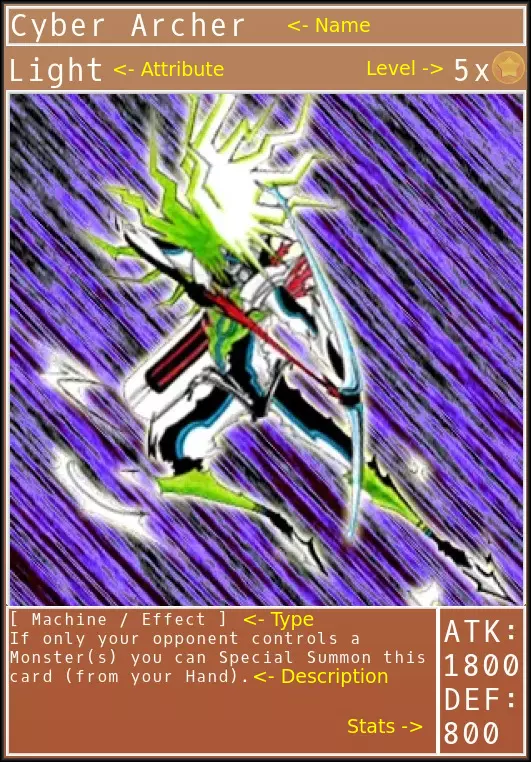Monsters
Summoned Monsters cards have a set pattern that is used during play. Trap cards, spells, and monsters have differently constructed cards.

Name - The name of the monster.
Attribute - (Element). Some cards (spells / traps / monster effects) only work on specific elements.
Level. Defines the strength of the monster. Monsters with level 4 or less can be summoned without Tribute, monsters with level 5 and 6 - by 1 Tribute, above level 6 - 2 Tribute.
Type - Some cards only work on a specific type of monster.
Description. Contains the type of effect. In case of cards without effect - contains general tidbit about the card.
Stats. Monster cards have 2 statistics. Attack Points define strength in offensive position and Defense Points in defensive position.
Monster types
Monster types
There are 6 types of monsters used in Summoned Monsters game.
Normal are the simplest form of monsters. They have no Effect, but often have better stats than monsters with an Effect (as long as it is a positive effect).
Effect is a group of monsters with effects that change abilities of monsters. Effects can be negative (then the monster has higher stats) or positive (lower stats).
Fusion is a group of monsters that are summoned by combining specific monsters (called Fusion Materials) using a card (usually Fusion). Each fusion card has a description of what monsters are needed to summon them. Most Fusion monsters do not have descriptions. Fusion monsters do not use summoning limits.
Ritual is a group of monsters that are summoned by using a special dedicated card (spell) and by sacrificing monsters from the field or hand of the same level as the ritual monster or more. Additionally, a ritual monster must be in your hand. Ritual monsters do not use the summoning limits.
Flip is a subgroup of Effect monsters. It differs in that the effect only activates when the face-down card is flipped. This situation is most common when a monster is attacked or the owner flips a card from face-down to face-up position.
Toon is a subgroup of Effect monsters. These are special monsters dedicated to use with Toon Story. Such monsters usually cannot attack in the first turn, but they can make a direct attack if the opponent does not have a Toon monster.
Attack and Defense Positions
A monster card can be placed in two positions - attack and defense. Monsters in the attack position are arranged vertically, and monsters in the defense position are arranged horizontally.
Monsters in the attack position use their ATK factor. Monsters in the defense position use their DEF coefficient. Monsters in the defense position do not attack. If a monster has not attacked in a turn, it can change position.
Attack scenarios:
Two monsters in attack position fight each other. The weaker monster is destroyed (goes to the graveyard), and the difference in attack points goes as player damage.
In the case of two equal Attack point ratios, the monsters are destroyed (no damage).
Defense scenarios:
If a monster in Attack Position attacks a monster in Defense Position, then:
If the monster has less DEF than the attacking ATK, the defending monster is destroyed (but without damage to the enemy).
If the monster has the same amount of DEF as the attacking ATK, no monster is destroyed.
If the monster has more DEF than the attacking ATK, no monster is destroyed, but the difference in DEF and ATK points is dealt to the attacker.
Face-Down and Face-Up Defense Position
There are two defense positions for monster cards, and they have a key effect on the cards actions. These are the face-down position and the face-up position.
If you are summoning a monster normally or a specific effect forces you to summon a card this way - you summon the monster in the face-down position. This means that:
The opponent does not know what card is underneath.
FLIP effects can be activated (it means that the card changes its position from Face-Down to Face-Up).
A face-down card is revealed when:
You want to change the position (from Face-Down Defense to Attack Position)
The card will be attacked (from Face-Down Defense to Face-Up Defense Position).
Once a card is revealed, it cannot be reversed to the Face-Down state.
Face-Up Defense position is mostly summoned by special summons or spells. So the opponent knows what card we have and can decide whether to attack it or not.